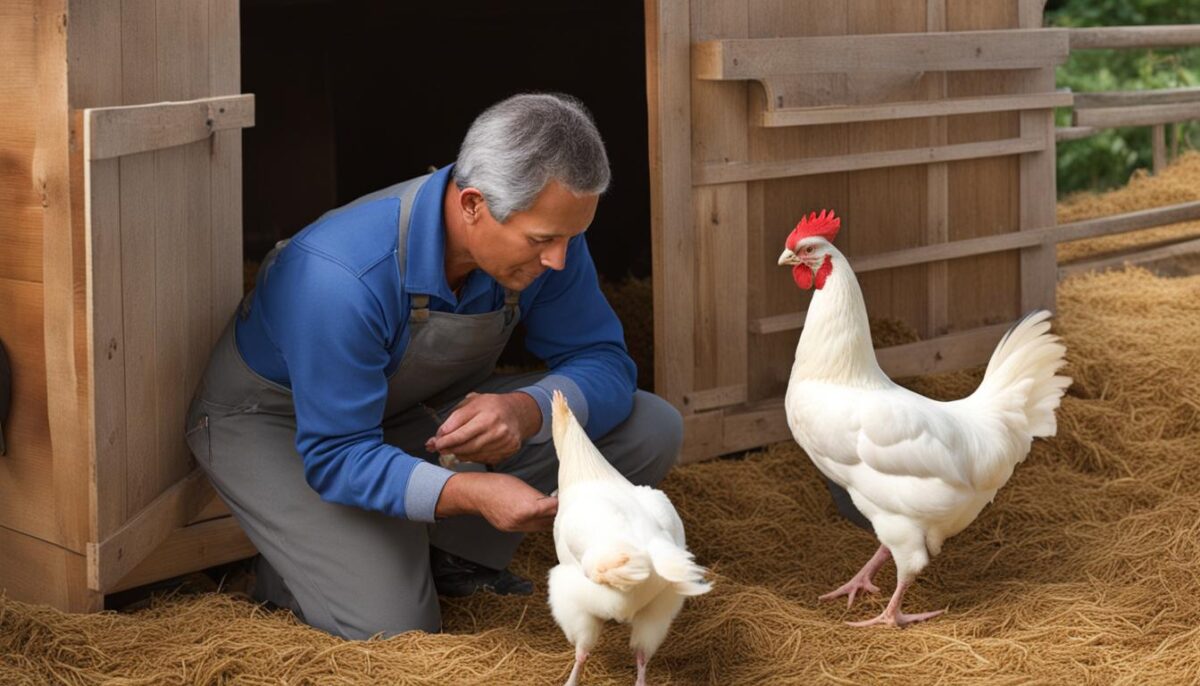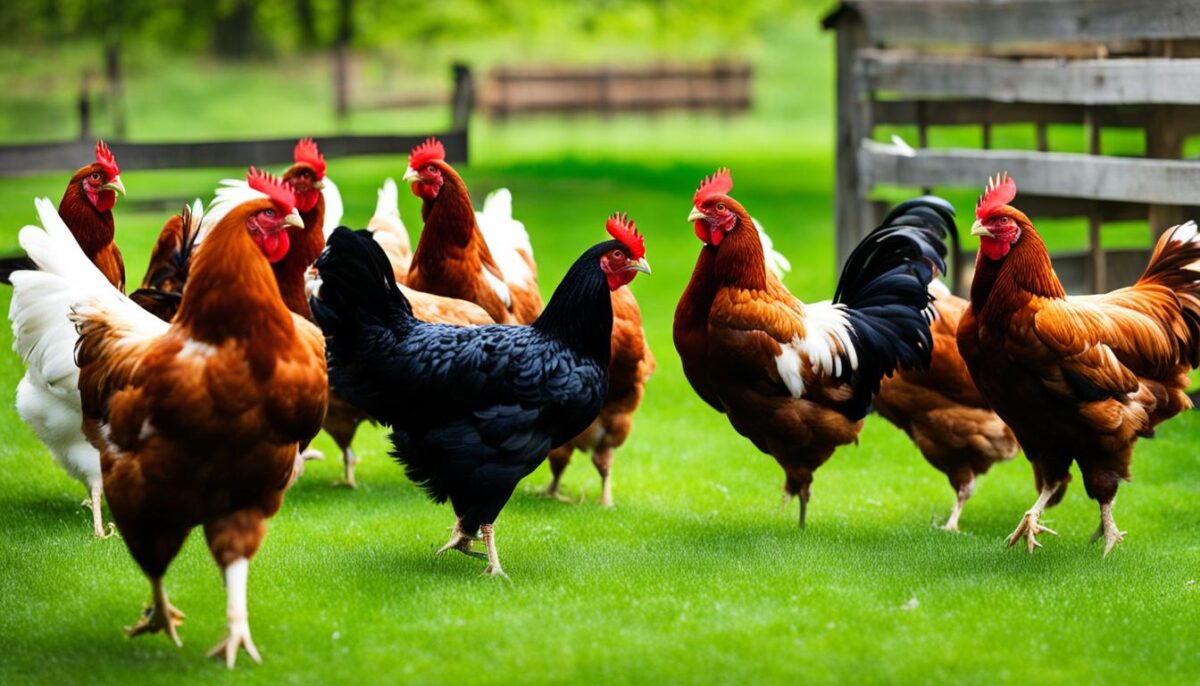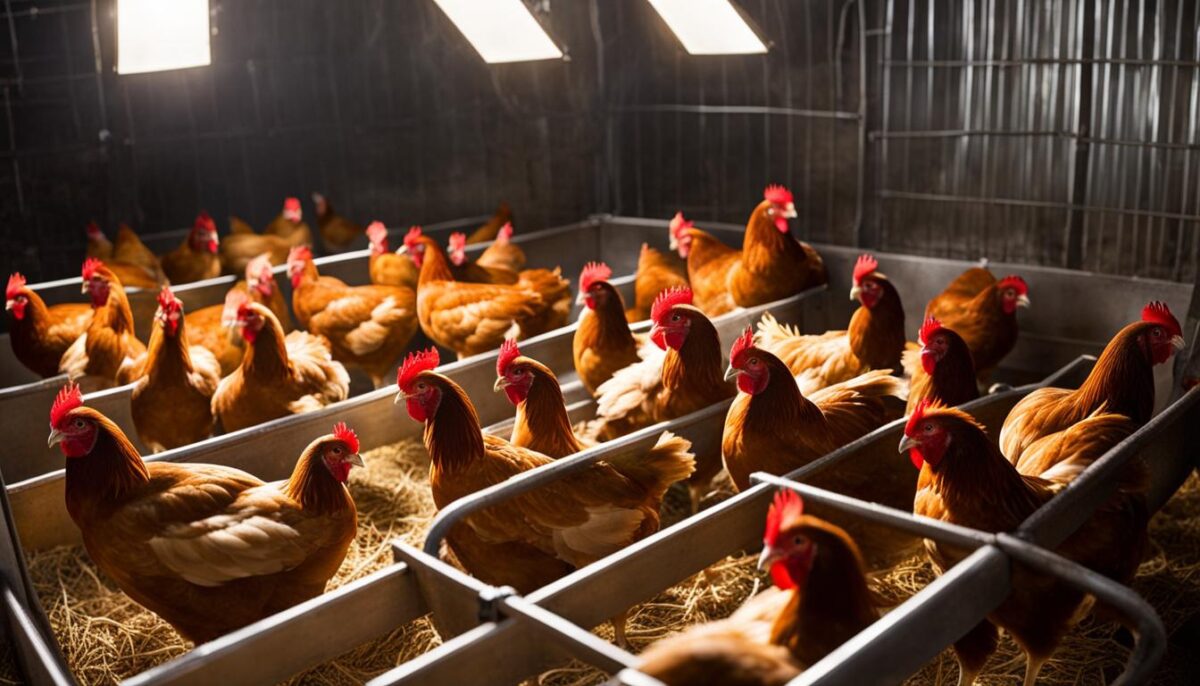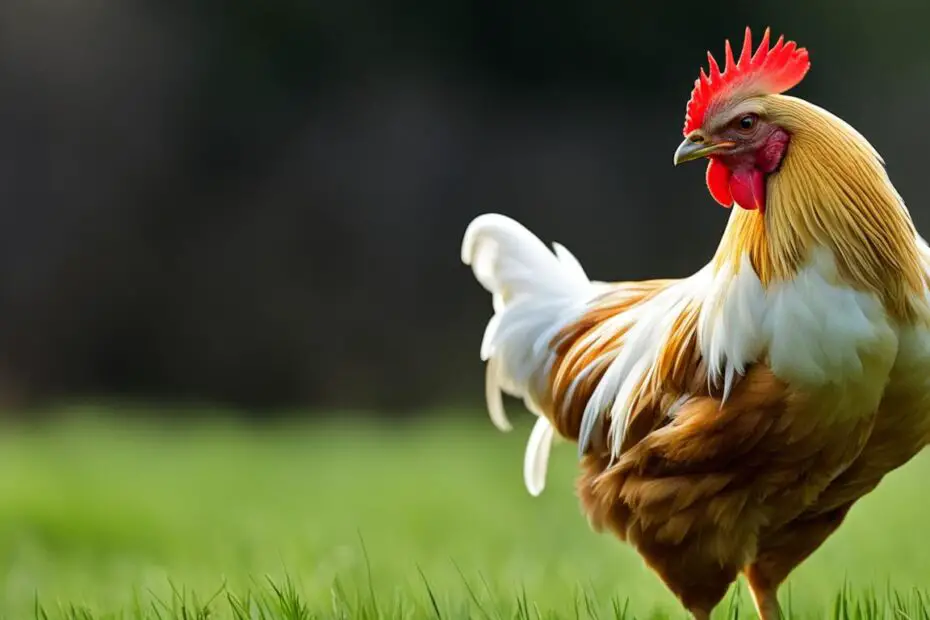Cornish Cross chickens are a popular breed known for their fast growth rate and high meat yield. If you’re considering breeding these chickens, it’s important to understand the ins and outs of the process. In this article, we’ll explore tips and techniques for successfully breeding Cornish Cross chickens.
Key Takeaways:
- Learn how to breed cornish cross chickens effectively
- Discover cornish cross chicken breeding tips for success
- Raise healthy and productive cornish cross chickens
- Understand the challenges and benefits of breeding this breed
- Maximize your meat yield with proper breeding techniques
Understanding Cornish Cross Chickens: Origins and Characteristics
The Cornish Cross chicken, also known as the Cornish-Rock, is a hybrid breed that was developed in the 1950s in the United States. It was created by crossing the Cornish and White Plymouth Rock breeds, resulting in a bird with exceptional meat production qualities. Cornish Cross chickens are known for their rapid growth, high feed efficiency, and heavy meat yield.
These chickens have a stocky build, broad breast, and white feathers. They are bred specifically for meat production and are not suitable for egg-laying purposes. When selecting parent stock for breeding, it is essential to choose birds with desirable traits such as size, weight, and overall conformation to ensure the best possible offspring.
“The Cornish Cross chicken is a result of careful breeding to meet the demands of the meat industry. By selectively crossing the Cornish and White Plymouth Rock breeds, we have created a bird that excels in growth rate, feed efficiency, and meat yield. It’s a breed that has revolutionized the poultry industry and continues to be the go-to choice for meat production.”
Table: Cornish Cross Chicken Characteristics
| Characteristic | Description |
|---|---|
| Breeds | Cornish and White Plymouth Rock |
| Appearance | Stocky build, broad breast, white feathers |
| Growth Rate | Rapid growth |
| Feed Efficiency | High feed conversion ratio |
| Meat Yield | Heavyweight and excellent meat quality |
Understanding the origins and characteristics of Cornish Cross chickens is crucial for successful breeding. By selecting the right parent stock and providing optimal care and nutrition, breeders can maximize the potential of these birds and produce high-quality meat for consumption.
Pros and Cons of Raising Cornish Cross Chickens
When it comes to breeding Cornish Cross chickens, there are several pros and cons to consider. Understanding these factors can help you make an informed decision before embarking on this venture. Let’s take a closer look at the benefits and challenges of raising Cornish Cross chickens.
Benefits of Raising Cornish Cross Chickens
- Fast growth rate: Cornish Cross chickens are renowned for their rapid growth, reaching market weight in as little as 6 to 8 weeks. This makes them an ideal choice for meat production, as they can be ready for processing in a relatively short timeframe.
- High meat yield: Due to their large size and broad breast, Cornish Cross chickens have a high meat-to-bone ratio. This means you can expect a substantial amount of meat per bird, making them efficient for meat production.
- Excellent meat quality: Cornish Cross chickens are known for their tender and flavorful meat. Their superior meat quality makes them a popular choice among consumers who appreciate delicious and succulent chicken.
While these benefits make Cornish Cross chickens appealing, there are also challenges to consider when breeding them.
Challenges of Raising Cornish Cross Chickens
- Health issues: The rapid growth rate of Cornish Cross chickens can lead to various health problems, including leg issues and heart failure. Proper care and management are crucial to mitigate these risks and ensure the well-being of the birds.
- Diet management: Cornish Cross chickens require strict diet management to prevent overgrowth. Their feed must be carefully regulated to strike a balance between promoting growth and avoiding excessive weight gain that can lead to health complications.
- Inability to breed back: Cornish Cross chickens are a hybrid breed, which means they cannot be bred back to each other for sustainable meat production. This limitation requires you to rely on specific parental stock to produce more broilers, adding complexity to the breeding process.
By considering these pros and cons, you can make an informed decision about whether breeding Cornish Cross chickens aligns with your goals and resources. Remember to prioritize the well-being and welfare of the birds to ensure a successful breeding experience.

Health and Care Tips for Cornish Cross Chickens
Cornish Cross chickens require special care to ensure their health and well-being. Proper nutrition is essential for their rapid growth and development. They need a high-protein diet to support their fast growth rate. It is recommended to feed them a protein-rich meat bird feed with a protein content of 22-24%. This will help them achieve their full potential and ensure optimal muscle development.
Additionally, clean and fresh water should be readily available to Cornish Cross chickens at all times. They have high water intake requirements to support their growth, and dehydration can lead to serious health issues. Regularly check their water supply and ensure it is clean and free from contaminants.
It is worth noting that Cornish Cross chickens are prone to certain health problems due to their rapid growth. If they are allowed to grow beyond 10 weeks, they may experience leg problems and heart failure. To prevent these issues, it is important to process them by 10 weeks of age. This ensures that they are harvested at the optimal time, maximizing their meat yield and minimizing the risk of health complications.
Key Health and Care Tips:
- Provide a high-protein meat bird feed with a protein content of 22-24% to support rapid growth.
- Ensure clean and fresh water is always available to prevent dehydration and support hydration needs.
- Process the chickens by 10 weeks of age to prevent leg problems and heart failure.
By following these health and care tips, you can help ensure the well-being and optimal growth of your Cornish Cross chickens. Remember to monitor their condition closely and address any health issues promptly to maintain a healthy flock.
| Health and Care Tips for Cornish Cross Chickens |
|---|
| Provide a high-protein meat bird feed with a protein content of 22-24% to support rapid growth. |
| Ensure clean and fresh water is always available to prevent dehydration and support hydration needs. |
| Process the chickens by 10 weeks of age to prevent leg problems and heart failure. |
Housing and Environment for Cornish Cross Chickens
Cornish Cross chickens, despite their rapid growth and meat production capabilities, require specific housing and environmental conditions to thrive. Providing them with a comfortable and controlled environment is essential for their well-being. While they are not heat or cold hardy, steps can be taken to ensure their comfort in extreme temperatures.
Chicken Tractor and Cleanliness
A chicken tractor is a suitable housing option for Cornish Cross chickens. This portable coop can be moved daily, allowing the birds access to fresh grass and preventing the buildup of waste. The regular movement of the tractor ensures cleanliness and minimizes the risk of odor. Additionally, it helps simulate their natural foraging behaviors even though they are not great foragers.
Protection from Predators
Due to their stocky build and fast growth, Cornish Cross chickens may have difficulty evading predators in a free-range system. Therefore, it is crucial to provide them with secure housing to protect them from potential threats. This can include sturdy fences, predator-proof enclosures, and appropriate shelter.
Temperature Regulation
Cornish Cross chickens are not naturally equipped to handle extreme temperatures. In hot weather, it is important to provide shade, ventilation, and access to cool water to prevent heat stress. Similarly, in cold weather, adequate insulation and heating measures should be implemented to keep the birds warm.

Tips for Successful Breeding of Cornish Cross Chickens
When it comes to breeding Cornish Cross chickens, there are a few key tips to keep in mind for a successful venture. Following these guidelines will help ensure the health and productivity of your flock.
Proper Housing and Environment
Cornish Cross chickens require a comfortable and controlled environment to thrive. Housing them in a chicken tractor that is moved daily will help maintain cleanliness and encourage natural foraging behaviors. It’s important to note that these chickens are not great foragers and may have trouble evading predators in a free-range system. Additionally, since they are not heat or cold hardy, appropriate measures should be taken to keep them cool in hot temperatures and warm in cold temperatures.
Diet and Nutrition
A high-protein diet is crucial for the rapid growth of Cornish Cross chickens. Feeding them a protein-rich meat bird feed with a protein content of 22-24% is recommended. It’s also important to provide them with access to clean, fresh water at all times. Additionally, offering grit to the chickens is essential for healthy digestion.
Feeding Schedule and Butchering
Establishing a strict feeding schedule is vital for the health of Cornish Cross chickens. It’s recommended to restrict their food intake 12 hours before processing to empty their digestive system, making processing easier. Butchering the birds by 10 weeks of age is crucial to prevent health issues such as leg problems and heart failure that can arise if they are allowed to grow beyond this point.
By following these tips, you can increase your chances of successfully breeding Cornish Cross chickens and enjoy the benefits of their fast growth rate and high meat yield.
The Economic Significance of Cornish Cross Chickens
Cornish Cross chickens play a significant role in the poultry industry, especially in commercial meat production. They are highly efficient in converting feed to meat, making them a cost-effective choice for meat producers. Their high meat yield and fast growth rate contribute to their popularity among farmers and homesteaders who want to raise their own meat chickens. However, it is important to keep in mind that Cornish Cross chickens are not a sustainable meat source for breeding purposes, as they require specific parental stock to produce more broilers.
In commercial meat production, Cornish Cross chickens are in great demand due to their ability to quickly reach market weight. They have a feed conversion rate of approximately 2:1, which means they require only 2 pounds of feed to gain 1 pound of body weight. This high efficiency in converting feed to meat significantly reduces the cost of production for meat producers, making Cornish Cross chickens a preferred choice in the industry.
“The high meat yield of Cornish Cross chickens makes them an attractive option for meat producers, as they can quickly produce a large quantity of meat per bird. This is especially beneficial for commercial operations that require a steady supply of meat for the market.”
For farmers and homesteaders, raising Cornish Cross chickens for meat provides an opportunity to have a self-sufficient source of high-quality meat. Their fast growth rate allows farmers to raise and process them within a relatively short period of time, typically around 8 to 10 weeks. This makes them an ideal choice for those who want to raise their own meat chickens without the need for extensive long-term management.
| Benefit | Explanation |
|---|---|
| High meat yield | Cornish Cross chickens can produce a large quantity of meat per bird due to their broad breast and fast growth rate. |
| Fast growth rate | These chickens reach market weight in a short period of time, typically around 8 to 10 weeks. |
| Cost-effective | The high feed conversion rate of Cornish Cross chickens makes them a cost-effective choice for meat production. |
| Self-sufficiency | Raising Cornish Cross chickens allows farmers and homesteaders to have a reliable source of high-quality meat. |
While Cornish Cross chickens offer many benefits for meat production, it is important to note that they are not suitable for sustainable breeding. Due to their hybrid genetics, they require specific parental stock to produce more broilers. This limits their use to commercial meat production or raising for personal use. To continue breeding Cornish Cross chickens, breeders must acquire new parental stock from reputable Cornish Cross chicken breeders.
In conclusion, Cornish Cross chickens have significant economic significance in the poultry industry. Their high meat yield, fast growth rate, and cost-effectiveness make them a preferred choice for commercial meat production. Additionally, they provide an opportunity for farmers and homesteaders to raise their own meat chickens. However, it is important to understand that Cornish Cross chickens are not a sustainable meat source for breeding purposes and require specific parental stock to produce more broilers.
The Impact of Commercialization on Cornish Cross Chickens
The development of the Cornish Cross chicken was driven by the demand for a chicken breed that could meet the needs of the commercial meat industry. As grocery stores became more popular, the focus shifted from raising dual-purpose breeds to strictly breeding broilers. The Cornish Cross quickly became the most commonly raised breed for meat production due to its growth rate and meat yield. This shift towards commercialization led to the control of breeding lines by major corporations in the industry.
Today, many cornish cross chicken breeders are affiliated with these corporations, supplying them with parent stock to be raised and processed for meat production. The focus on breeding for commercial purposes has resulted in a standardized genetic line that produces birds with the desired characteristics of rapid growth and high feed efficiency. These birds are raised in controlled environments and fed specialized diets to maximize their growth potential.
While commercialization has undoubtedly made the Cornish Cross chicken a highly efficient meat producer, it has also raised concerns about the genetic diversity and long-term sustainability of the breed. The controlled breeding practices have limited the genetic pool, making the birds more susceptible to health issues and reducing their ability to adapt to different environments. This has led to a higher reliance on antibiotics and other interventions to maintain the health and productivity of the birds.
“The commercialization of Cornish Cross chickens has transformed the poultry industry. While it has allowed for increased meat production and cost effectiveness, it has also raised questions about the welfare and long-term viability of the breed.”
It is important to recognize the impact of commercialization on the Cornish Cross breed and its implications for the future. While the breed’s characteristics make it well-suited for large-scale meat production, small-scale producers and backyard farmers should carefully consider the challenges associated with breeding and raising Cornish Cross chickens. Exploring alternative breeds or focusing on sustainable breeding practices may be more suitable for those seeking to produce their own meat on a smaller scale.
Raising Cornish Cross Chickens for Meat: A Comparative Overview
| Aspect | Cornish Cross Chickens | Alternative Breeds |
|---|---|---|
| Growth Rate | Rapid (6-8 weeks) | Slower |
| Feed Efficiency | High | Varies |
| Meat Yield | High | Varies |
| Genetic Diversity | Low | Higher |
| Health Issues | Higher susceptibility | Varies |

Conclusion
Breeding Cornish Cross chickens can be a fulfilling endeavor for meat production. These hybrid birds are known for their fast growth rate and high meat yield. However, it is important to carefully consider the pros and cons before embarking on this venture.
On the positive side, Cornish Cross chickens offer significant advantages, including their ability to quickly reach market weight and their exceptional meat quality. These traits make them a popular choice for commercial meat production. By following best practices for breeding, providing a high-protein diet, and ensuring proper care and housing conditions, you can successfully raise Cornish Cross chickens for meat.
However, it is crucial to be aware of the challenges involved. Cornish Cross chickens have specific health issues due to their rapid growth, such as leg problems and heart failure. Additionally, their inability to breed back to each other makes them less suitable for sustainable meat production on a small scale.
In conclusion, while breeding Cornish Cross chickens requires careful consideration and attention to their unique needs, it can be a rewarding venture for meat producers. By understanding the breed’s characteristics, following breeding tips, and providing optimal care, you can raise healthy and productive Cornish Cross chickens for meat.
FAQ
What is a Cornish Cross chicken?
Cornish Cross chickens are a hybrid breed developed by crossing the Cornish and White Plymouth Rock breeds. They are known for their fast growth rate and high meat yield.
What are the benefits of breeding Cornish Cross chickens?
Breeding Cornish Cross chickens offers advantages such as fast growth, a large amount of meat produced per bird, and excellent meat quality.
What are the challenges of breeding Cornish Cross chickens?
Some challenges of breeding Cornish Cross chickens include health issues due to rapid growth, the need for strict diet management, and the inability to breed them back to each other for sustainable meat production.
What is the recommended diet for Cornish Cross chickens?
Cornish Cross chickens require a high-protein diet, with a recommended protein content of 22-24%. They also need access to clean, fresh water at all times.
What health issues can arise in Cornish Cross chickens?
If allowed to grow beyond 10 weeks, Cornish Cross chickens can experience leg problems and heart failure. It is important to process them by 10 weeks to prevent these issues.
What housing and environmental conditions are best for Cornish Cross chickens?
Cornish Cross chickens can be housed in a chicken tractor that is moved daily for cleanliness. They are not great foragers and may have trouble evading predators in a free-range system. They also require a controlled environment as they are not heat or cold hardy.
How can I successfully breed Cornish Cross chickens?
To successfully breed Cornish Cross chickens, it is recommended to keep them in a chicken tractor, provide a high-protein feed, offer grit for digestion, and stick to a strict schedule for feeding. Butcher the birds by 10 weeks to prevent health issues.
What is the economic significance of Cornish Cross chickens?
Cornish Cross chickens are highly efficient in converting feed to meat, making them cost-effective for meat producers. Their high meat yield and fast growth rate contribute to their popularity in the poultry industry.
What is the impact of commercialization on Cornish Cross chickens?
Commercialization has led to the control of breeding lines by major corporations in the industry. This has shifted the focus from raising dual-purpose breeds to strictly breeding broilers, with the Cornish Cross becoming the most commonly raised breed for meat production.


